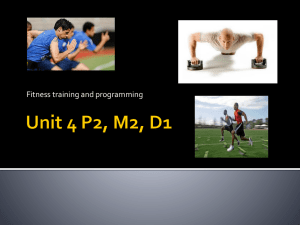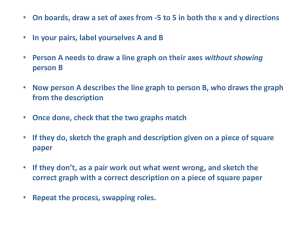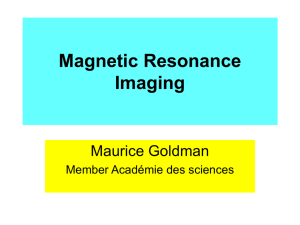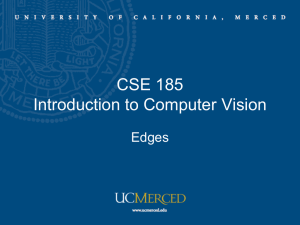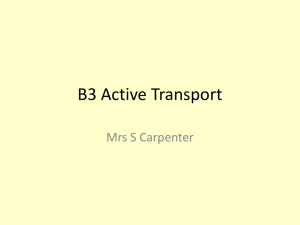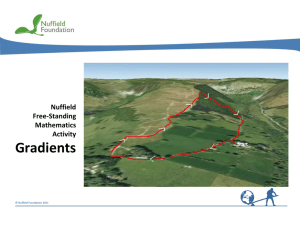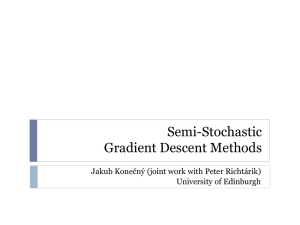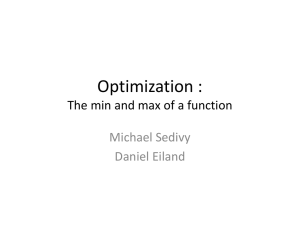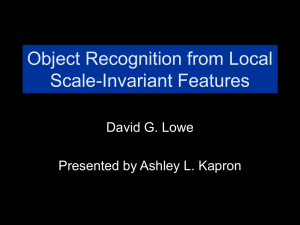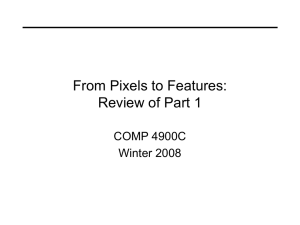Convolutional filters
advertisement
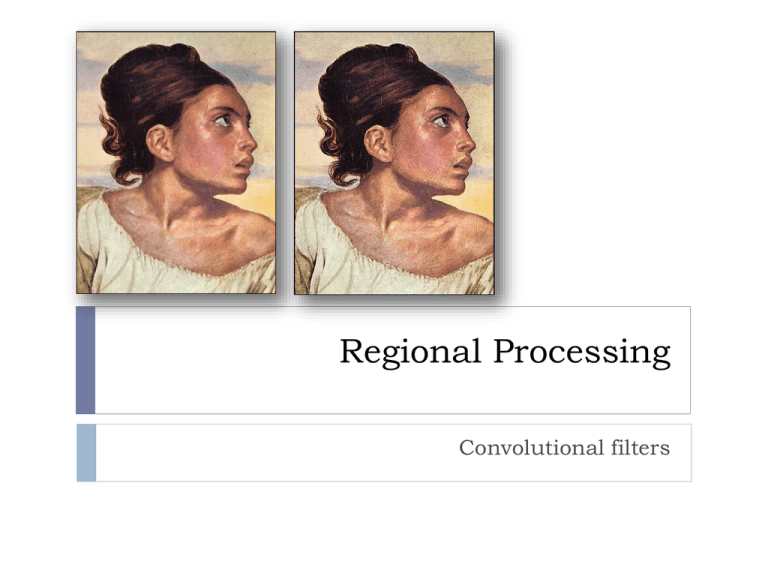
Regional Processing
Convolutional filters
Smoothing
Convolution can be used to achieve a variety of effects
depending on the kernel.
Smoothing, or blurring, can be achieved through convolution
and is often used to reduce image noise or to prepare an
image for further processing stages.
Smoothing is accomplished by any kernel where all of the
coefficients are nonnegative.
Two classes of smoothing filters are commonly used.
Uniform filter: all non-zero coefficients are identical
Weighted (non-uniform) filter: Coefficients are larger near the
center and smaller near the periphery.
Smoothing
Smoothing
Smoothing
The equations for
Pyramid:
Cone:
Gaussian:
Pyramid and Cone are non-smooth
Gaussian has desirable characteristics:
Smooth
Separable
Gaussian Smoothing
Gaussian is parameterized on the standard deviation
Large sigma’s reduce the center peak and spread the
information across a larger area
Smaller sigma’s create a thinner and taller peak
Gaussian is separable – find A and B factors
Gaussian is radially symmetric which implies A = BT
Use the equation below where sigma controls the kernel shape
and alpha controls the discrete kernel size where W =
ceiling(alpha * sigma) and alpha is usually in [2,5].
Gaussian Smoothing
Consider generating a kernel using
Alpha = 2
Sigma = 1
Compute W = ceiling(2 * 1) = 2
This is the half-width of the kernel. The kernel is then 5x5
A and B are 5x1 and 1x5 respectively
Using the equation we obtain non-normalized A and B as
Normalized and rounded as {1, 4, 7, 4, 1}
Java function
Smoothing Example
Edges
An edges is a rapid transition between light and dark areas in an image.
Two common concerns:
Edge detection
Sharpening
The goal of edge detection is to identify locations in an image where the
transition is strong.
Strong edges likely indicate component boundaries
Edges can be enhanced to sharpen an image
Blurring reduces the strength of edges while sharpening strengthens the edge
strength.
Averaging is analogous to integration while sharpening is analogous to
differentiation.
Derivative filters are usually used for edge detection
The derivative is a measure of color change over distance
Edges
Edges: Gradient
An edge is indicated by local extrema in the derivative
The derivative of a multi-variate function is known as the
gradient and is a measure of the change that occurs in
each dimension of the function.
Images are functions of two variables: (x, y)
The gradient measures both horizontal and vertical change
The gradient at a single location (x,y) is given as the 2x1 vector
Edges: Gradient
The gradient of the entire image is a table of such vectors
and is known as a vector field.
The gradient is a vector and can be represented in either
Cartesian coordinate space or polar coordinates.
Polar coordinates are a (radius, orientation) pair
Polar coordinates are often more useful since the coordinates
directly correspond to edge strength (radius) and edge
direction (orientation)
Conversion from Cartesian to Polar is straightforward:
Edges: Gradient
The gradient is a measure of the slope, or grade, at all points
within the image.
Analogy: Consider a hiker who seeks to climb a hill by taking
the most efficient path upwards. When standing at any point
on the hill, the gradient
tells the hiker in which direction to take his next step (this is the
orientation component) and
how much higher that step will take him (this is the r, or magnitude,
component).
The gradient at a particular location is therefore a two- dimensional
vector that points toward the direction of steepest ascent where the
length (or magnitude) of the vector indicates the amount of change
in the direction of steepest ascent.
The orientation of the gradient is therefore perpendicular to any
edge that may be present.
Digital Approximation of the Gradient
Since digital images are not continuous but discrete, the gradient must be
approximated rather than analytically derived.
Numerous methods for approximating the gradient of a discrete data set
are in common use. Let’s start with a simple method
Consider a 3x3 region of an image having samples centered at Sc, where the
subscript stands for the center, and the surrounding samples are positioned
relative to the center as either up/down or left/right as indicated by the
subscripts. Given this information, we would like to approximate the amount of
change occurring in the horizontal and vertical directions at location (x, y) of
image I.
Digital Approximation of the Gradient
What is the horizontal and vertical change at Sc?
Can approximate this change by:
50
35
55
75
40
55
90
90
30
200
75
80
25
75
95
85
5
40
50
35
45
-120
70
10
-20
165
20
5
-15
20
5
-5
Gradients via Convolution
The gradient can be approximated via convolution.
Consider the kernels Gx and Gy which measure the
horizontal and vertical changes:
Prewitt Operators
The previous approximations are noise-sensitive since a single
noisy sample will greatly influence the gradient.
The Prewitt operators are kernels for use in convolution.
They average the difference across the central element and hence
provide some immunity to noise.
Prewitt Example
Sobel Operators
Sobel operators both blur (average) and differentiates and
image.
The operators are weighted with greater emphasis on the key
element
Roberts Cross-Gradient operators
Measure change in the upper-left-to-bottom-right and
bottom-left-to-upper-right diagonals rather than the
horizontal and vertical axes.
Are 2x2 with the key element in the upper-left
Roberts Example
Magnitude of Gradient
Edge detection algorithms typically key on the magnitude of
the gradient (MoG) since larger magnitudes directly
correspond to greater probability of an edge.
Computing the MoG is a fundamental building block in image processing.
The MoG is defined in 6.18
An edge map is the inverse of the MoG
Can detect edges by threshholding the MoG. Magnitudes above the
threshold are assumed to be on an edge.
The MoG can be approximated as the sum of the horizontal and vertical
magnitudes rather than the more computationally consuming sqrt of the
sum-of-squares
MoG Implementation
Author a BufferedImageOp class to generate the magnitude of gradient
from a source image.
Let’s use the first approach described in the text
Gx = [-1, 0, 1] and Gy = [-1, 0, 1]T
Use of edges
Edge Enhancement via Convolution
Edge enhancement is often known as sharpening. It
boosts the high-frequency components of an image rather
than suppressing the low-frequency components
Can be achieved via convolution but what kernel(s)
should we use?
Consider that an image is the sum of the low and high
frequency components
Boost the high-frequency component by a scaling factor alpha
Edge Enhancement via Convolution
Solve 6.20 for Ihigh and substitute into 6.21
This equation can then be used to generate appropriate sharpening kernels
Assume that I = I convolved with Kidentity and Ilow = I convolved with Klow
Edge Enhancement via Convolution
Edge Enhancement via Convolution
The parameter alpha can be considered a gain setting that
controls how much of the source image is passed through
to the sharpened image.
When alpha= 0 no additional high frequency content is passed
through to the output such that the result is the identity
kernel.
Higher scaling factors correspond to stronger edges in the
output.
Edge Enhancement

